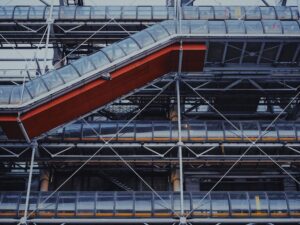The mid-20th century was a time of transformation and innovation. Visual arts movements and disciplines were on the rise, from new realism to minimalism, performance and pop art. The era reflected an overall mood of creativity and social liberation, driving forces which were often captured in the images of Harry Shunk (1924-2006) and János Kender (1937-2009). From the late 1950s onwards, the duo photographed events in Paris and New York, producing an archive of revolutionary documentation whilst experimenting with the lens in the public eye. Galerie de Photographies at the Centre Pompidou, Paris, hosts a retrospective spanning 1857 to 1983, featuring images of over 500 artists who were framed by Shunk and Kender, including Yves Klein, Jean Tinguely, Niki de Saint Phalle, Andy Warhol and Robert Rauschenberg.
The duo first met in Paris in 1957 and quickly joined forces, immortalising large events such as exhibitions and performances, but also depicting practitioners at work in the studio or home. Shunk and Kender began building close relationships with their subjects, which led to intimate, deeply personal images which captured the emotional and often tangled processes of sitter and artist as they unfold. Quickly becoming closer to Pierre Restany (1930-2003) and the New Realists, the pair also embarked on a productive relationship with Yves Klein (1928-1962), whose career ranged from signature blue paintings to experiments in performance, all reflecting a fascination with space and the idea of voids.
Centre Pompidou draws attention to the duo’s most famous collaborations, such as the 1960 work Saut dans le Vide (Leap into the Void), which depicts Klein leaping from a second-floor window and appearing to fly. The piece culminates in two images – one of the empty street and one of the artist leaping whilst friends held a tarpaulin for landing. Following works like these, Shunk and Kender crossed the Atlantic in 1967, following Niki de Saint Phalle and Jean Tinguely to Montreal, before moving on to New York and documenting its infamous art world, capturing pioneering exhibitions such as Software at the Jewish Museum of New York (1970) – one of the first shows to consider the impact of information technology – as well as dynamic performances by groundbreaking names Yayoi Kusama and Nam June Paik.
Valuation and reputation in the art world has long been a controversial and mystifying topic (to wit: Kusama’s paintings are now worth around $7 million.) Following new films that go behind the scenes – such as Nathaniel King’s documentary The Price of Everything – Centre Pompidou’s exhibition sheds light on credibility, visibility and population before the digital age. Shunk and Kender’s photographs captured the social sphere of gallerists and dealers, populating the media as the original influencers behind the lens.
Until 5 August. Find out more here.
Lead image: Shunk-Kender, Pier 18 John Baldessari, New York, Winter 1970-1971. Gift of the Roy Lichtenstein Foundation in memory of Harry Shunk and Janos Kender (2014). Photography: Shunk-Kender © J.Paul Getty Trust. All rights reserved © Centre Pompidou/MNAM-CCI/Bibliothèque Kandinsky, Photothèque RMN-Grand Palais.





